- Unit24 Apr 2014
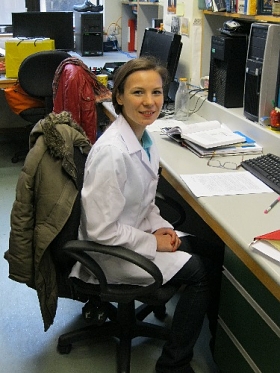
We are pleased to welcome Miss Husniye Hacioglu Bay to the Unit as a Visiting Student. Husniye is currently studying for her PhD at the Neuroscience Programme of Marmara University, Turkey. She joins the Unit to receive advanced training and pursue her anatomical projects, as part of a collaboration between Prof. Umit Sehirli and Unit scientists Dr. Juan Mena-Segovia and Prof. Paul Bolam.
Husniye graduated from the Biology Teaching Department of Marmara University in 2006. She achieved her two MSc degrees between 2006-2012 (Microbiology, in the Art and Science School, and Anatomy, in the School of Medicine). Husniye has also worked as a Research Assistant at the Anatomy Department since 2009. During this time, she has worked on projects focussed on epilepsy and the thalamus, together with Prof. Safiye Cavdar and Prof. Ray Guillery FRS, an Honorary Emeritus Research Fellow at the Unit.
- Unit24 Apr 2014
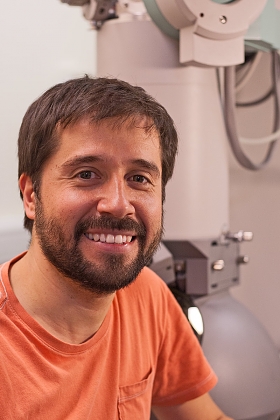
Dr. Pablo Henny, a former postdoctoral scientist in Professor Paul Bolam’s Group, has returned to the Unit as a Visiting Scientist for 3 months. During his visit, Pablo will continue work on a project that he started back in the Unit, namely to characterize the axon initial segment of midbrain dopaminergic neurons using electron microscopy.
Pablo is currently an Assistant Professor at the School of Medicine, Pontificia Universidad Catolica de Chile in Santiago, Chile, where he is responsible for the courses in Human Neuroanatomy. He is also head of the Neuroanatomy Laboratory, and has a special interest in dopaminergic neurons and motoneurons. His visit and project are co-funded by a grant from the Chilean Agency for Science and Technology (FONDEYCT/CONICYT) and the Pontificia Universidad Catolica de Chile.
- Unit29 Mar 2014

On the 29th of March 2014, Prof Ian W. Chubb, Chief Scientist of Australia and the Unit Director, Prof Peter Somogyi planted a fastigiate oak (Quercus robur fastigiata) to commemorate the start of their historical collaboration 40 years ago in 1974, under the supervision of A. David Smith in the Department of Pharmacology. The projects on the release of acetylcholinesterase from the adrenal medulla (Somogyi, Chubb & Smith 1975; Somogyi & Chubb 1976) led to continuing translational research programmes both in Australia by Ian Chubb and in Oxford by David Smith. Subsequent work eventually led to the approval by the MRC of setting up the Anatomical Neuropharmacology Unit 30 years ago, in 1984. The oak was kindly supplied by the University Parks Service. Such trees live for up to 500 years, which resonates well with the long-term research programmes and influence of the Unit. The budding oak also provides a fitting start for the new MRC Brain Network Dynamics Unit at the Department of Pharmacology, University of Oxford from 2015 under the directorship of Peter Brown, Professor of Experimental Neurology at the Nuffield Department of Clinical Neurosciences.
- Unit16 Mar 2014
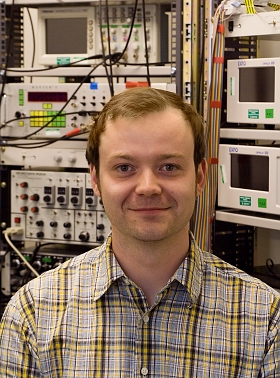
We are pleased to announce that Dr. Peter Magill, MRC Unit Programme Leader, has received a prestigious New Investigator Award from The Wellcome Trust. These Awards are intended to support independent, early-career researchers of exceptional promise, who can already show that they have the ability to innovate and drive advances in their field of study. Dr. Magill will use his Award to fund a new research programme that will capitalise on his Group’s recent discovery that nerve cells of the external globus pallidus are well suited to perform a ‘division of labour’ in helping the brain to control voluntary movements.
Dr. Magill commented, “I am delighted to have received this New Investigator Award. It not only reflects my achievements, but also the excellent work of my Group members and collaborators, past and present. It is also a fitting recognition of the outstanding intellectual environment and technical infrastructure that are established at the MRC Unit and University Department of Pharmacology. It is an exciting time for everyone involved in this research, and we look forward to starting the programme.”
- Unit15 Mar 2014
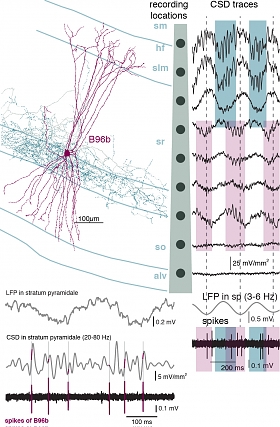
Electrical oscillations in the gamma frequency range (30 - 120 Hz) can be recorded from many brain areas including the rodent hippocampus, where they reflect pyramidal cell spike-timing and information encoding. However, several dynamically changing oscillators may contribute independent electrical activities in this range. How do the different oscillators interact and how is their independence maintained in the hippocampal circuit? Lasztóczi and Klausberger recorded, labelled and identified individual neurons by glass electrodes together with isolated constituents of gamma oscillations by current-source-density analysis in vivo. They found two distinct gamma oscillations in the hippocampal CA1 area: gammaperisomatic, a fast oscillation around the pyramidal cell layer coupled to the theta trough and gammaapical tuft, a slower oscillation on theta peaks spatially restricted to the distal dendritic layers. Parvalbumin-expressing, GABAergic basket cells are coupled to gammaperisomatic only, with temporal alignment consistent with their role as local gamma-current generators. The spatiotemporal selectivity of basket cell firing reflects circuit organization and contributes to the regulation and maintenance of independent information flows within the CA1 circuit.
- Unit12 Mar 2014
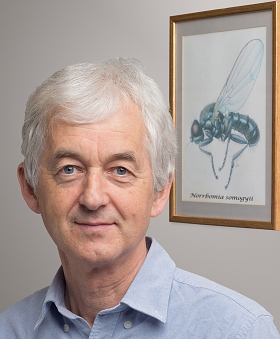
Unit director Peter Somogyi receives Honorary Doctorate from the University of Zurich. Prof Dr Michael Hengartner the President greeted Peter as the latest Honorary Doctor of the prestigious University of Zurich. The title will be bestowed on him in a ceremony Dies Academicus on the 26th of April. Peter collaborated with world leading neuroscientists the late Peter Streit and the current head of the Department of Pharmacology and Toxicology Prof Jean-Marc Fritschy. Prof Hengartner wrote “I take great pleasure in informing you of the decision of the Faculty of Medicine to award you an honorary doctorate. This high distinction recognizes and honors your outstanding achievements in research on neuronal circuits in the cerebral cortex “. In his acceptance letter Peter replied: “I am delighted to learn that the Faculty of Medicine recommended the awarding of an honorary doctorate to me of you esteemed University, which I hold in the highest regard”.
- Unit11 Mar 2014
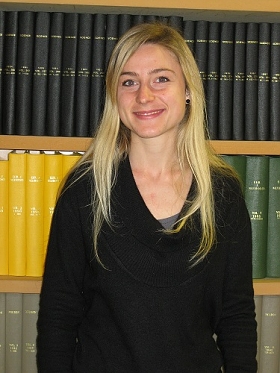
Giulia joins the group of Marco Capogna supported by the Erasmus Placement Exchange. She will join a project investigating 5-HT-mediated interneuron signalling in normal and 5-HTT over-expressed mice (March-September 2014). Giulia is currently a student of the Master Degree in Neuroscience at the University of Trieste, Italy.
- Unit4 Mar 2014
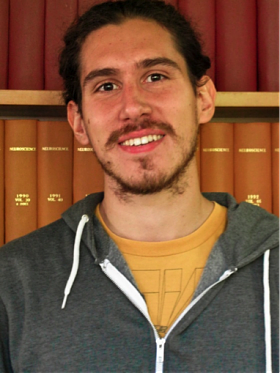
Marco Bocchio wins the Gotch Memorial Prize 2013 for the best DPhil Transfer Status report of an Oxford graduate student in the field of Physiology. The award is £1,000.
The title of his transfer report is "Serotonergic neuromodulation of the mouse amygdala".
Abstract
Recent studies in animals and humans have proven that serotonergic neurotransmission in the Basolateral Amygdala (BLA) is a critical component for the regulation of emotional behaviour and psychiatric disorders. However, the effects of serotonergic transmission on BLA neuronal network are currently poorly understood.
The report investigates the effect of serotonin (5-Hydroxytriptamine, 5-HT) on:
1) GABAergic interneurons (INs) innervating Principal Neurons (PNs) of the Basal Amygdala in mice overexpressing the serotonin transporter (5-HTT OE), an animal model displaying reduced anxiety; and 2) neurons of the Lateral Amygdala (LA) expressing neuronal nitric oxide synthase (nNOS), a cell type displaying Low-threshold Spiking (LTS) features.
The experiments described hereby show that overexpression of 5-HTT leads to a deficit in GABAergic INs activation in the Basal Amygdala (BA), namely reduced inhibition onto PN.
Additionally, 5-HT elicits a switch from tonic firing to burst firing of nNOS+ neurons of the LA, potentially driven by hyperpolarization. This contrasts with the known depolarizing action of 5-HT on other GABAergic populations investigated so far. The description of the anatomical aspects and electrophysiological responses of nNOS+ neurons is also addressed. Results suggest that this cell population is likely to be formed by long-range GABAergic projection neurons, the presence of which has never been reported in the BLA.
- Unit7 Feb 2014
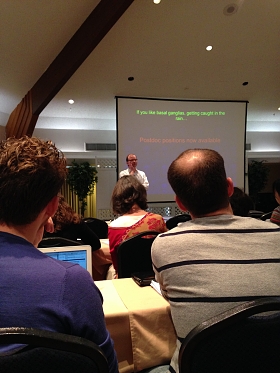 Pete Magill gives his talk at the GRC
Pete Magill gives his talk at the GRCMembers of the Magill and Bolam Basal Ganglia Labs attended the Gordon Research Conference on “Basal Ganglia Cells and Circuits in Health and Disease”, which was held in Ventura, California, from the 2nd – 7th February 2014. This is a new meeting that brings together leading groups to discuss the latest advances in the field of basal ganglia research, with a view to promoting discussion of unpublished data and fostering cross-cutting collaborations. Further emphasis was placed on showcasing developments that have translational significance. The meeting consisted of daily symposia and poster sessions.
The latest discoveries from the Unit’s Basal Ganglia Labs were well represented through symposium talks by Paul Bolam, Peter Magill and Juan Mena-Segovia.
Other lab members presented the following posters:
Daniel Dautan, Icnelia Huerta-Ocampo, Ilana Witten, Karl Deisseroth, Paul Bolam, Todor Gerdjikov & Juan Mena-Segovia. “A major external source of cholinergic innervation of the striatum and nucleus accumbens originates in the brainstem”
Albert Souza, Ilana B. Witten, Karl Deisseroth, J. Paul Bolam, Todor V Gerdjikov & Juan Mena-Segovia. “Dopamine neurons of the ventral tegmental area are differentially modulated by brainstem cholinergic pathways"
Paul D. Dodson, Ian C. Duguid, J. Paul Bolam & Peter J. Magill. “Distinct firing patterns of prototypic and arkypallidal neurons of the GPe during movement”
Farid Garas, Andrew Sharott & Peter J. Magill. “Molecular markers of novel populations of striatal interneurons”
Kouichi C. Nakamura, Andrew Sharott, Nicolas Mallet & Peter J. Magill. “Neuronal activity in the motor thalamus of dopamine-intact and Parkinsonian rats"
Federica Vinciati, Andrew Sharott, Kouichi C. Nakamura & Peter J. Magill. “In vivo electrophysiological properties of neurochemically-identified striatal neurons in dopamine-intact and Parkinsonian rats”
- Unit23 Jan 2014
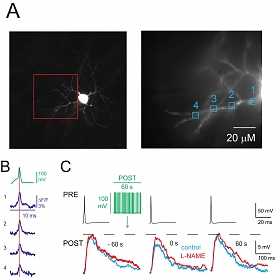 A) Left, image of an NGFC showing soma and characteristic stellate dendrites. This neuron was loaded with JPW-1114 and voltage imaging was performed from dendritic sites included in the red box; ΔF/F signals at the sites indicated (1-4, right picture) were analyzed. B) Depolarizing current pulse induced a somatic action potential (AP) recorded in current clamp (green) and the corresponding ΔF/F signals from the sites 1-4 (blu) are illustrated. Data not shown here suggest that AP back-propagation triggers increase of calcium concentration and release of nitric oxide from dendrites. C) Presynaptic APs (PRE, black traces) elicited depolarizing uIPSPs (control, left traces superimposed) recorded with an electrode filled with high Cl- solution showing FSI immediately after stimulation protocol (green traces) applied to a postsynaptic NGFC (control, blue middle trace). The uIPSP recovered 60 s after the stimulation protocol (blue trace, right). Application of the nNOS inhibitor L-NAME (200 μM) blocked FSI (red traces).
A) Left, image of an NGFC showing soma and characteristic stellate dendrites. This neuron was loaded with JPW-1114 and voltage imaging was performed from dendritic sites included in the red box; ΔF/F signals at the sites indicated (1-4, right picture) were analyzed. B) Depolarizing current pulse induced a somatic action potential (AP) recorded in current clamp (green) and the corresponding ΔF/F signals from the sites 1-4 (blu) are illustrated. Data not shown here suggest that AP back-propagation triggers increase of calcium concentration and release of nitric oxide from dendrites. C) Presynaptic APs (PRE, black traces) elicited depolarizing uIPSPs (control, left traces superimposed) recorded with an electrode filled with high Cl- solution showing FSI immediately after stimulation protocol (green traces) applied to a postsynaptic NGFC (control, blue middle trace). The uIPSP recovered 60 s after the stimulation protocol (blue trace, right). Application of the nNOS inhibitor L-NAME (200 μM) blocked FSI (red traces). The hippocampus contains more than 20 types of inhibitory interneurons that express different proteins and impinge on different regions of pyramidal cells to regulate spatiotemporal integration of EPSPs and define temporal windows for spiking. Neurogliaform cells (NGFCs) form synapses on the distal tufts of pyramidal cell apical dendrites alongside excitatory inputs from the entorhinal cortex. NGFCs express neuronal nitric oxide synthase (nNOS), are often synaptically coupled, and fire during theta oscillations in vivo. Li et al. published a “featured article” in the Journal of Neuroscience (34(4):1280-1292, 2014) reporting a novel physiological action mediated by this interneuron type. They found that when theta-associated activity patterns were evoked in NGFCs in hippocampal slices of rat or mouse, the cells showed a transient reduction in unitary IPSP amplitude. This “firing-induced suppression of inhibition” (FSI) required back-propagation of action potentials, calcium influx through L-type calcium channels, nNOS activity, and activation of NO-sensitive guanylyl cyclase (NO-sGC) receptors, which are present on presynaptic terminals. FSI also indirectly increased the amplitude of EPSPs. Thus FSI may enhance spatial and temporal summation of excitatory inputs to NGFCs, regulating their inhibition of pyramidal cells. More in general, this work demonstrates: 1) retrograde signaling initiated by “in vivo firing pattern”, 2) interneuron back-propagation detected with fast time resolution voltage imaging, and 3) physiological role for nNOS expressed by specific interneuron types.